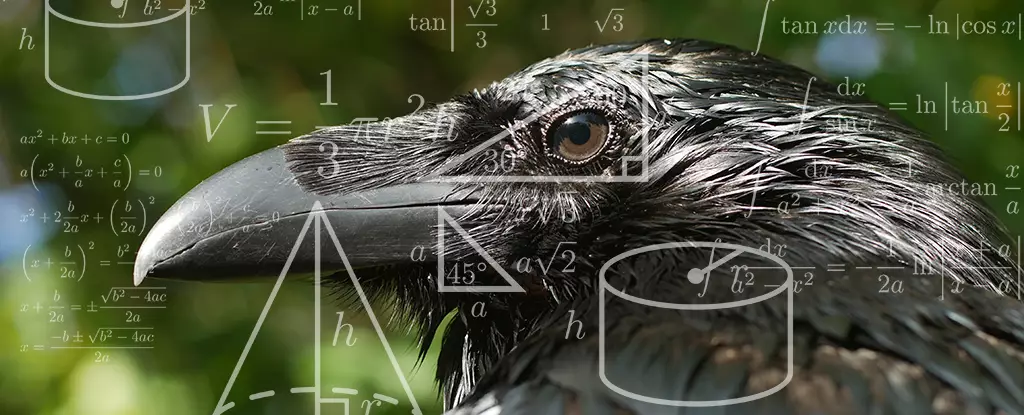The recent revelations about the geometric intuition possessed by crows illuminate the astonishing cognitive capabilities of these avian creatures. For centuries, we have distinguished ourselves from the animal kingdom based on our intellectual abilities, often undervaluing the cognitive complexities present in species that share our environment. The findings from research led by Andreas Nieder and his colleagues at the University of Tübingen serve as a powerful reminder of the rich cognitive tapestry woven into the fabric of evolution, challenging long-held assumptions that such abilities are inherent exclusively to humans. This study reveals not just the intelligence of crows but also urges us to reconsider our definition of intelligence itself.
Defying Conventional Wisdom
Traditionally, the realm of geometric understanding has been considered a human domain, characterized by our ability to recognize patterns, symmetries, and regularities with refined accuracy. The crows’ ability to discern the “odd one out” from a series of geometric shapes challenges this notion. The fact that crows can efficiently detect outliers based on geometric regularity positions them as formidable cognitive beings. Such findings prompt a critical examination of the biases we hold and the ways in which we perceive intelligence in non-human species. It naturally leads to the question: What else have we overlooked in the spectrum of animal intelligence?
Breaking Down the Experiment
In a meticulously designed series of experiments, researchers trained two male carrion crows to identify irregular shapes among consistent geometric patterns. Unlike typical lab animals, crows have not been socially conditioned to perform for rewards in a traditional sense. The way these crows instinctively discern patterns reveals an innate understanding of geometry that had remained uncharted until now. Their success in identifying an outlier among quadrilaterals, particularly those characterized by regular shapes like squares, underscores a shared cognitive foundation that we typically attribute to human prowess.
Furthermore, the study’s methodology cleverly reinforces the notion that the crows were not merely mimicking learned behaviors, but rather tapping into an intrinsic understanding of geometric principles. Through rigorous testing, the crows exhibited a solid ability to engage with and navigate their environment’s spatial properties—traits that are essential for survival. In a world where societal structures often leave little room for acknowledging sentience outside of human frameworks, this revelation sets the stage for a radical shift in our comprehension of non-human cognition.
The Broader Implications for Animal Intelligence
The implications of this study extend far beyond mere academic curiosity; they challenge our anthropocentric worldview. We must confront the uncomfortable reality that our species, so quick to extol its supremacy, may share fundamental cognitive abilities with other beings. As the study indicates, crows use geometric regularities for navigation and orientation, skills critical to their survival—functions that intertwine with their instinctual behaviors. This realization may promote a broader recognition of emotional and cognitive depth in various animals and inspire movements advocating for their rights and welfare.
Moreover, our growing understanding of avian intelligence could foster richer interactions between humans and animals. As we learn to appreciate crows’ capabilities, a newfound respect may develop, encouraging us to coexist more harmoniously with these intelligent birds. As our ethical considerations broaden to include an acknowledgment of their complex forms of intelligence, society may benefit from examining how we impact their habitats and lives.
Rethinking Intelligence Across Species
As we uncover the intricacies of crow intelligence, it becomes increasingly clear that our human-centric narrative regarding intelligence is flawed. Instead, we should embrace a more diverse understanding that recognizes the complex intelligence of various species. The cognitive similarities between crows and humans are compelling enough to warrant reconsideration of how educational frameworks and societal norms evolve to embrace these findings. Greater emphasis on humane education could help foster empathy, illuminating pathways toward a more compassionate coexistence with nature.
In a world increasingly troubled by the consequences of a human-centered focus, rethinking intelligence—especially in the realm of biodiversity—offers a glimmer of hope. By acknowledging that even the most unlikely candidates, like crows, possess sophisticated cognitive skills, we approach a more egalitarian understanding of intelligence, thereby embracing the richness of life in all its forms. The discoveries related to crow intelligence not only elevate our perception of these beings but also encourage a more profound connection with the animal world around us.

Leave a Reply